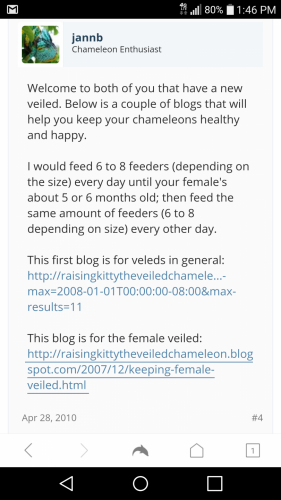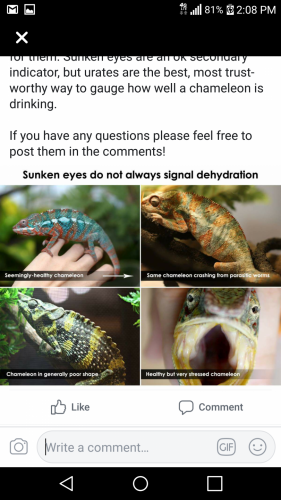dshuld
Chameleon Enthusiast
Are you actually from Weed, California, or is that a joke because 420
Yes, actually in Weed, California.
Follow along with the video below to see how to install our site as a web app on your home screen.
Note: This feature may not be available in some browsers.
Are you actually from Weed, California, or is that a joke because 420
Yup, Weed, California! It was called Weed long before Cannabis tried stealing the name! Lol. Named after the founder of the city! Sir Abner Weed!Are you actually from Weed, California, or is that a joke because 420
Are you actually from Weed, California, or is that a joke because 420
Well, I know where I'm going to be living out my glory days.Yup, Weed, California! It was called Weed long before Cannabis tried stealing the name! Lol. Named after the founder of the city! Sir Abner Weed!
I know right sameWell, I know where I'm going to be living out my glory days.
You are that amazing wife! Lol.And his wife is a proud graduate of Weed HighFor real!
Haha! That's amazing lol i love itYou are that amazing wife! Lol.
Lol ok cool that's good. He still over feeding her at that age though. She should be every other day
I would not restrict feeding to every other day. She actually does not look like a fully grown female and so should still be eating every day in my opinion. Generally as a female starts showing receptive colours is when I tweak feeding down to reduce egg follicle development. Then I feed more to ensure proper shell formation. Then after the first clutch the feeding is changed to every other day..
The mouth can be open for the common reasons of: 1) a respiratory infection. This is usually accompanied with other symptoms such as laboured breathing (the entire body of the chameleon inflates and deflates very strangely), a coughing noise, excess mucous in the mouth. 2) some sort of mouth rot infection that may have been caused by an insect bite and subsequent infection. 3) over heating (most common) when too hot the colours will lighten up and they will open up their mouths.
The black mark on the chin looks like it could be from rubbing it against some surface, maybe the cage screen.
The eyes are sunken so their is some dehydration.


With all the research about lingevity, all the research, on about 99% of all animals on this planet, it points to eating small meals (just barely reaching caloric intake needs) that are highly nutritious being the best plan! Meals that are low in carbohydrates, not too hight in protein and eating lots of fresh vegetables and fresh fruit are optimal! Even most carnivores in captivity bennifits from alterations in their diet to this direction! This is why gutloading the bugs for chameleons is so incredibly important!Everything I have ever read which I spend a fair amount of time doing trying to catch up to you old timers, though in all fairness is mostly on panthers, has said to reduce at the six month mark. I generally don't speak to veiled because I don't know them as well as panthers but, I have seen the same thing said multiple times for veileds. Here is just one example...
View attachment 208313
Dehydration is not the only reason for sunken eyes. Without having seen a poop pic that is an assumption made by you that may or may not be true. The cham is stressed, probably in more then one in that pic, and may be the only reason for sunken eyes. This is from a recent post by Olimpia Martonitti discussing this.
Hey everyone, let's talk about SUNKEN EYES for a minute. There is a common misconception that sunken eyes must always mean a dehydrated chameleon, and this is not always true!
STRESS: I know that as soon as a chameleon has sunken eyes our knee-jerk reaction is to think that chameleon must be dehydrated. A lot of times this can be the wrong diagnosis, and may distract from something else going on. The real reason chameleons' eyes sink in is because of stress; stress from being handled, stress from not feeling well (dehydration falls under this), and stress from something being wrong in their environment.
The panther chameleon in the two top pics, for example, is a perfect example of an animal that crashed suddenly and passed but for whom dehydration was never a part of the problem. You can see him on the left just a week or two before he passed healthy as can be; nice round, alert eyes, body nicely filled in, and energetic. On the left he was moments from passing, and his sunken eyes over the previous two days let me know that he was in decline. His urates were nice and white so I knew water was not the problem; there was something wrong with him internally making him feel ill/stressed. In the photo you can actually see them but a necropsy after death revealed he was full of worms!
In the bottom photos you an see a Meller's chameleon that is in poor condition in general. Bad body weight, probably poorly dehydrated, and probably very stressed overall. This is a chameleon that I would push fluids onto because I know that dehydration is probably part of the problem. However, the panther on the bottom right is stressed only because he is being handled (in this photo we needed a photo of his gumline) but is otherwise healthy. Upon letting him go his eyes went right back to normal.
URATES: The most sure-fire way of telling how well-hydrated a chameleon is is by looking at their urates, the chalky portion of their waste that is not digested food. This is essentially the "urine" portion. Like with us, the color of their urates tells us exactly how well they are hydrating. The more white or ivory it is the better hydrated they are, while the farther towards yellow and orange it goes the more we need to consider upping the misting/humidity for them. Sunken eyes are an ok secondary indicator, but urates are the best, most trust-worthy way to gauge how well a chameleon is drinking.
If you have any questions please feel free to post them in the comments!
View attachment 208315
Everything I have ever read which I spend a fair amount of time doing trying to catch up to you old timers, though in all fairness is mostly on panthers, has said to reduce at the six month mark. I generally don't speak to veiled because I don't know them as well as panthers but, I have seen the same thing said multiple times for veileds. Here is just one example...
View attachment 208313
Dehydration is not the only reason for sunken eyes. Without having seen a poop pic that is an assumption made by you that may or may not be true. The cham is stressed, probably in more then one in that pic, and may be the only reason for sunken eyes. This is from a recent post by Olimpia Martonitti discussing this.
Hey everyone, let's talk about SUNKEN EYES for a minute. There is a common misconception that sunken eyes must always mean a dehydrated chameleon, and this is not always true!
STRESS: I know that as soon as a chameleon has sunken eyes our knee-jerk reaction is to think that chameleon must be dehydrated. A lot of times this can be the wrong diagnosis, and may distract from something else going on. The real reason chameleons' eyes sink in is because of stress; stress from being handled, stress from not feeling well (dehydration falls under this), and stress from something being wrong in their environment.
The panther chameleon in the two top pics, for example, is a perfect example of an animal that crashed suddenly and passed but for whom dehydration was never a part of the problem. You can see him on the left just a week or two before he passed healthy as can be; nice round, alert eyes, body nicely filled in, and energetic. On the left he was moments from passing, and his sunken eyes over the previous two days let me know that he was in decline. His urates were nice and white so I knew water was not the problem; there was something wrong with him internally making him feel ill/stressed. In the photo you can actually see them but a necropsy after death revealed he was full of worms!
In the bottom photos you an see a Meller's chameleon that is in poor condition in general. Bad body weight, probably poorly dehydrated, and probably very stressed overall. This is a chameleon that I would push fluids onto because I know that dehydration is probably part of the problem. However, the panther on the bottom right is stressed only because he is being handled (in this photo we needed a photo of his gumline) but is otherwise healthy. Upon letting him go his eyes went right back to normal.
URATES: The most sure-fire way of telling how well-hydrated a chameleon is is by looking at their urates, the chalky portion of their waste that is not digested food. This is essentially the "urine" portion. Like with us, the color of their urates tells us exactly how well they are hydrating. The more white or ivory it is the better hydrated they are, while the farther towards yellow and orange it goes the more we need to consider upping the misting/humidity for them. Sunken eyes are an ok secondary indicator, but urates are the best, most trust-worthy way to gauge how well a chameleon is drinking.
If you have any questions please feel free to post them in the comments!
View attachment 208315
You could argue that a chameleons feeding schedule should be altered at 6 months of age .... assuming that the chameleon has finished growing. That's all I'm saying. I dont think you can apply a cut off age just based on one (or a few) keepers chameleons who reach sexual maturity at 5 to 6 months age. But if the chameleon is a full sized adult by 6 months age then yes reduce food.
I offered a list of the common causes for what the symptoms are. Sunken eyes "do not always mean dehydration" but it is a (confirmed) common symptom of dehydration that can be easily corrected and allows elimination of possibilities of the eyes being sunken in - if they are generally sunken in most the time. Also dehydration is a VERY common thing with new keepers. But you could be right that it is stress because the chin rub bruise could indicate stress too - the chameleon is trying to get out the cage because it could be threatened by some thing? That's assuming the chameleon didn't fall and bump the chin to get that bruise.
Me too! It’s on Wednesday. But don’t think he will find out much. As our “exotics” vet isn’t very knowledgeable.Awesome, glad to hear. When is her vet appointment? I'm still curious as to any finding they may have in her case.
Me too! It’s on Wednesday. But don’t think he will find out much. As our “exotics” vet isn’t very knowledgeable.
I took my Ambilobe and she did not do any tests or tell me anything helpful unfortunately